How the Russians took the impregnable fortress of Corfu
A.V. Suvorov
220 years ago, in March 1799, Russian sailors, under the command of Admiral Fyodor Ushakov, captured the French strategic fortress of Corfu in the Mediterranean. The victory was won during the Mediterranean campaign of the Black Sea squadron 1798 - 1799.
prehistory
At the end of the XVIII century, the political life of Europe was full of important events. The French bourgeois revolution became one of them and caused a whole chain of new major events. At first, the monarchies surrounding France tried to strangle the revolution and restore the royal power. Then France began the "export of revolution", which soon transformed into a normal imperial, predatory expansion. France, having achieved serious success in transforming society and the army, created its continental empire.
The first invasive campaigns France made in the Mediterranean region. In 1796 - 1797 French forces led by Napoleon Bonaparte defeated the Austrians and their Italian allies, conquered Northern Italy. In May 1797, the French captured the Ionian islands belonging to Venice (Corfu, Zante, Kefalonia, St. Moors, Cerigo and others) located off the western coast of Greece. The Ionian Islands were of strategic importance, as they allowed to control the Adriatic Sea, to influence the western part of the Balkans and the eastern part of the Mediterranean Sea. In 1798, the French took control of the Papal States in Central Italy, proclaiming the Roman Republic. In the north of Europe, the French put Holland under their control, under the name of the Republic of Batavia.
In May 1798, Napoleon launched a new aggressive campaign - the Egyptian. Napoleon planned to seize Egypt, build the Suez Canal and go further to India. In June 1798, the French seized Malta and landed in Egypt in early July. The British fleet made a number of mistakes and could not intercept the French army at sea. In August, British ships under the command of Admiral Nelson destroyed the French fleet in the battle of Aboukir. This significantly worsened the supply and position of the French in Egypt. However, the French continued to hold a strategic position in the Mediterranean - Malta and the Ionian Islands.
Pavel I stopped the participation of Russia in the war with France (First Anti-French Coalition). He wanted to completely revise the policy of his mother Catherine II. However, the capture of Malta by the French was perceived in the Russian capital as an open challenge. Russian emperor Pavel Petrovich was the Grand Master of the Order of Malta. Malta was formally under Russian protectorate. In addition, soon after the invasion of the French army into Egypt and Napoleon’s attempts to occupy Palestine and Syria, Porta was asked to help in the fight against Bonaparte. Constantinople was afraid that the invasion of Napoleon could cause the collapse of the empire.
In December, 1798, Russia concluded a preliminary agreement with Britain on the restoration of anti-French alliance. December 23 1798 (January 3 1799) Russia and Turkey signed an agreement by which ports and Turkish straits were open to the Russian fleet. Traditional enemies - Russians and Ottomans, became allies against the French. Even before the conclusion of an official union, it was decided that Russia would send the Black Sea Fleet to the Mediterranean.
Mediterranean trip
In Petersburg, they decided to send a squadron of the Black Sea Fleet to the Mediterranean. When this plan arose in the capital, the Black Sea squadron under the command of Vice-Admiral F. F. Ushakov was on the march. About four months the ships plowed the waters of the Black Sea, only occasionally entering Sevastopol. In early August, 1798, the squadron of Ushakov made another stop at the main fleet base. Immediately, Ushakov was given the Emperor's command: to go to cruise in the Dardanelles area and, at the request of Porta, to fight against the French together with the Turkish fleet. On the preparation for the campaign gave only a few days. That is, the high command approached the march irresponsibly, he was poorly prepared. Ships and crews were not prepared for a long hike, from one hike they were almost immediately thrown into a new one. Hope was the high fighting qualities of Ushakov, his officers and sailors.
At dawn 12 August 1798, the Black Sea squadron consisting of 6 battleships, 7 frigates and 3 ship messengers set sail. On the ships was the landing - 1700 grenadier of the Black Sea Navy battalions. There was a lot of excitement at sea, a leak opened on the ships, so two battleships had to be returned to Sevastopol for repair.
In Constantinople, Ushakov held talks with representatives of Porta. The British ambassador also took part in the negotiations in order to coordinate the actions of the allied squadrons in the Mediterranean. As a result, it was decided that the Russian squadron would go to the west coast of the Balkan Peninsula, where its main task would be the liberation of the Ionian Islands from the French. For joint operations with the Russians, a squadron under the command of Vice Admiral Kadir-Bey (consisting of 4 battleships, 6 frigates, 4 corvettes and 14 gunboats) was assigned to the Turkish fleet, which was subordinate to Ushakov. “Ushak Pasha,” as Turkish sailors called the Russian admiral Fyodor Fyodorovich Ushakov, in Turkey they were afraid and respected. He has repeatedly hit the Turkish fleet at sea, despite its numerical superiority. On behalf of the Sultan, Kadir Bey was told to "read our admiral Yako teacher." Constantinople assumed obligations to supply the Russian squadron with everything necessary. The local Turkish authorities were ordered to fulfill the requirements of the Russian admiral.
In Dardanelles, the Black Sea squadron joined the Turkish fleet. From the combined fleet, Ushakov singled out the 4 frigate and 10 gunboats under the general command of Captain 1-rank A. A. Sorokin, this detachment was sent to Alexandria for the blockade of French troops. Thus, assistance was provided to the allied British fleet under the command of Nelson.
20 September 1798, the ships of Ushakov headed from the Dardanelles to the Ionian Islands. The liberation of the Ionian Islands began from the island of Cerigo. The French garrison took refuge in the fortress of Kapsali. September 30 Ushakov offered the French to surrender the fortress. The French refused to capitulate. October 1 began shelling the fortress. After some time, the French garrison laid down weapon. It is worth noting that the arrival of the Russian squadron and the beginning of the liberation of the Ionian Islands from the French invaders caused great enthusiasm among the local population. The French were hated for looting and violence. Therefore, the Greeks in every way began to help the Russian sailors. The Russians saw defenders from the French and the Turks.
Two weeks after the liberation of the island of Cerigo, the Russian squadron approached the island of Zante. The French commandant, Colonel Lucas, took measures to defend the island. Built on the banks of the battery to prevent the landing of troops. Locals warned the Russians about this. Two frigates under the command of I. Shoshko approached the coast to suppress enemy guns. The Russian ships approached the range of the shotgun and made the enemy batteries silence. A landing party was landed. He, together with the local militias, blocked the fortress. Colonel Lyukas capitulated. At the same time, the Russians had to protect the prisoners from revenge from local residents who hated the invaders.
At Zante Island, Admiral Ushakov divided his forces into three units: 1) four ships under the flag of the captain of the 2 rank D. N. Sinyavin went to the island of St. Moors; 2) six ships under the command of Captain 1 of the rank of I. A. Selivachev headed for Corfu; 3) five ships under the command of the captain of the 1 rank I.C. Pokochin - to Kefalonia. The liberation of Kefalonia took place without a fight. The French garrison fled to the mountains, where he was captured by the locals. Russian trophies were 50 guns, 65 barrels of gunpowder, over 2500 cores and bombs.
On the island of sv. Moors French Colonel Miolet refused to capitulate. A landing party with artillery landed from the ships of Senyavin. Started shelling the fortress, which lasted 10 days. However, it did not come to the assault, the French, after the bombing and the arrival of the ships of Ushakov, went to the negotiations. 5 November the French laid down their arms. Russian trophies were 80 guns, over 800 guns, 10 thousands of cores and bombs, 160 pounds of gunpowder, etc. After taking possession of the island of St. The Moors of Ushakov came to Corfu to attack the strongest French fortress in the Ionian Islands.
Squadron of Admiral Ushakov in the Bosphorus. Artist M. Ivanov
French forces
The first came to Corfu squad Selivacheva. October 24 (November 4) 1798, the Russian ships reached Corfu. This fortress was considered one of the most powerful in Europe. Located on the east coast of the island, the fortress consisted of a whole complex of strong fortifications. In the eastern part of it was located the citadel (old fortress). The citadel was separated from the city by a moat. From the sea, the citadel defended the high bank; moreover, the stronghold was surrounded on all sides with a double high rampart, and throughout the rampart there were stone bastions. This Byzantines began to build this fortress, then the Venetians built it. The city was defended by the New Fortress. It began to build the Venetians, and brought to perfection the French engineers. The fortress consisted of casemates carved into the rocks, which were connected by underground galleries. Two rows of walls connected by a complex system of aisles and corridors.
On the west side, the city was defended by three forts: Fort Abraham, Fort San Roque and Fort Salvador. They defended the city from the land. More 600 guns were in service with Corfu fortifications. From the sea, the city was defended by the fortifications of Vido Island, located at a distance of artillery shots from Corfu Island. Vido was the advanced outpost of the main fortress and was also well fortified. On the island there were five artillery batteries. In addition, the French had ships. The expanse of water between Corfu and Vido was a haven for French ships. There were two battleships here - the 74-cannon “Zheneros” and the 54-cannon “Leander”, the 32-cannon corvette “Labrune”, the bombardier ship “Freemar”, the brig “Expedition”. Total 9 pennants that had more 200 guns.
The French garrison led by General Chabot and General Commissar Dubois numbered more than 3 thousand soldiers, 1 thousand seamen from ships could support him. On the island of Vido, under the leadership of General Pevron, there was a 500 man.
Old fortress
New fortress
Siege fortress
Arriving at Corfu, a detachment of Selivachev (3 battleship, 3 frigate and several small ships) began the blockade of the enemy fortress. Three ships took up a position on the Northern Strait, the rest - on the South Strait. Captain-Lieutenant Shostak was sent to French command as a truce, who proposed the enemy to surrender the sea fortress without a fight. The French Military Council rejected this proposal.
The French made an attempt to conduct reconnaissance in force and test the strength and fortitude of the Russian detachment. The ship Genener 27 of October left the harbor and began to converge with the Russian ship Zachary and Elizabeth. Approaching the distance of the artillery shot, the French opened fire. The Russian ship immediately replied. The French did not accept the proposed battle and immediately retreated. At the same time, attempts by several French ships to break into the fortress failed: the 18 gun brig and 3 vehicles were captured by Russian ships.
October 31 The Selivachev detachment was reinforced by one Russian battleship (Holy Trinity), 1798 with Turkish frigates and a corvette. On November 2, the main forces of Ushakov came out to Corfu, and a few days later Senyavin's squadron arrived (the 9 battleships and the 3 frigate). Having distributed forces to carry the sea blockade, Ushakov conducted reconnaissance of the island. Intelligence and information of local Greeks showed that the French occupied only fortifications, in the local villages of the enemy was not. The Russian admiral decided to land the landing forces immediately.
The Russian ships approached the port of Gouvy, which was located a few kilometers from Corfu. Here was a village with an old shipyard, but the French destroyed it along with all the forest reserves. Nevertheless, here the Russian sailors began to equip a basing point where ships could be repaired.
In order not to allow the French to replenish their supplies with the help of robbery of the surrounding villages, the Russians, with the help of local residents, began to build artillery batteries and earthworks near the fortress. On the north bank, a battery was placed on the hill of Mont-Oliveto. From the North battery it was convenient to fire on the advanced forts of the enemy. For the construction of the battery was landed troops under the command of Captain Kikin. For three days the work was completed and on November 15 the battery opened fire on the French fortress.
The siege of Corfu from land and sea lasted over three months. The French, counting on the impregnable bastions of the fortress, large reserves, hoped that the Russians would not withstand a long siege and leave Corfu. The French troops tried to wear down the enemy, to keep them in constant tension, so they constantly made artillery shelling and attacks. This required constant readiness from the Russian troops to repel the attack. “The French garrison, which is in Corfu,” wrote Admiral Ushakov, “is active and tireless.”
The whole weight of the siege of the enemy fortress was borne by Russian sailors and soldiers. Assistance from the Turks was limited. The Turkish command did not want to risk their ships, and therefore tried to refrain from fighting. Ushakov himself wrote about this: "I am on their bank, like a red egg, and in danger ... I do not let in, and they themselves are not hunters to that." At the same time, the Turks happily robbed the already defeated French, were ready to cut them out if not for the Russians.
On the night of January 26 1799, the battleship Zhenérés (having painted the sails black) together with the brig, following Napoleon’s instructions, broke through the naval blockade and left for Ancona. The Russian patrol vessel noticed the enemy and gave a signal about it. Two Russian frigates fired at the enemy, but in the dark their shots did not reach the target. Ushakov gave a signal to Kadyr Bey to go after the enemy, but the Turkish flagship remained in place. As a result, the French successfully left.
The siege of Corfu exhausted the forces of the French garrison. However, the Russians had to be extremely hard. There was nothing to storm the enemy. Ushakov wrote that in stories There are no examples when the fleet was at such a distance without any supply and at such an extreme. The Russian squadron near Corfu was very remote from its bases, and was literally deprived of all that was needed for people and ships. The Turkish authorities were in no hurry to fulfill their obligations to supply the ships of Ushakov. The Turks did not allocate ground troops for the siege of the fortress. The same situation was with artillery and ammunition. There was no land siege artillery, cannons, howitzers, mortars, ammunition, there were not even bullets for guns. The lack of ammunition led to the fact that the Russian ships and batteries, built on land, were silent. Shot only in the most extreme case.
The real disaster was in the field of supplying the expedition with food. For months, the sailors literally starved, as the supplies did not come either from Russia or from Turkey. Ushakov wrote to the Russian ambassador in Constantinople that they feed on the latest crumbs. In December, 1798 from Russia to Corfu arrived transport with food, but the long-awaited corned beef was rotten.
There was no normal supply. The sailors did not receive salaries, uniforms, money for uniforms, and were almost undressed, without shoes. When the squadron received the long-awaited money, they were useless, as they were sent in paper banknotes. Nobody accepted such money, even at a greatly reduced price.
In Petersburg, they did not at all represent the gravity of the position of the Russian squadron at Corfu. At the same time they tried to "steer" the ships of Ushakov, without representing the real military-strategic situation in the region. Ships from the Russian squadron were constantly sent to various places — sometimes to Ragusa, then to Brindisi, Otranto, Calabria, etc. This made it difficult to concentrate all forces to take Corfu. At the same time, the successes of the Russians in the Ionian Islands greatly disturbed our British "partners." They themselves wanted to establish themselves in this region. When the Russians began the siege of Corfu, the British began to demand that Ushakov allocate ships to Alexandria, Crete and Messina in order to weaken the Russian forces. The British tried to get the Russians to break the siege of Corfu, and then they themselves could capture this strategic point.
Storming the fortress of Corfu. From the painting by artist A. Samsonov
To be continued ...
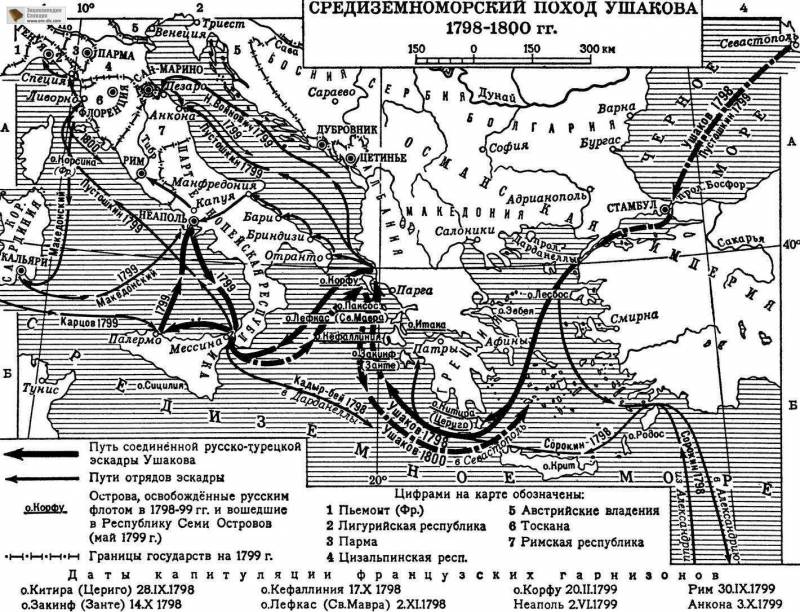
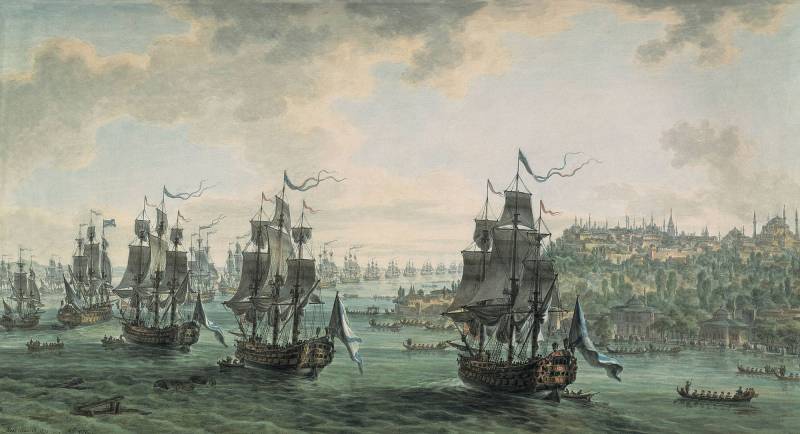
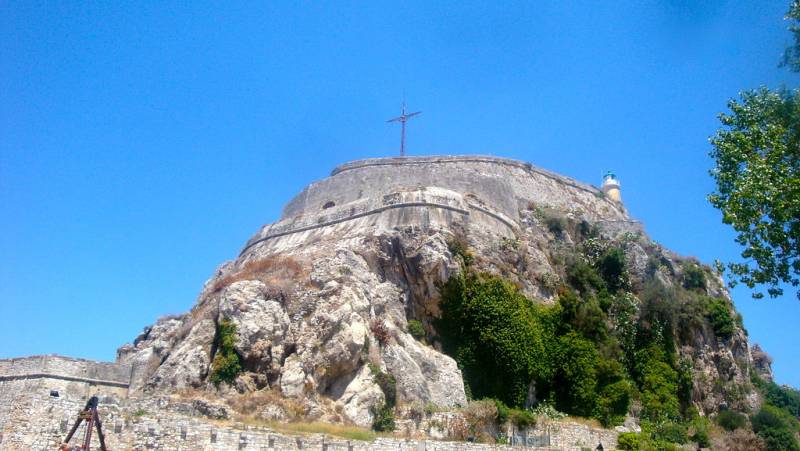
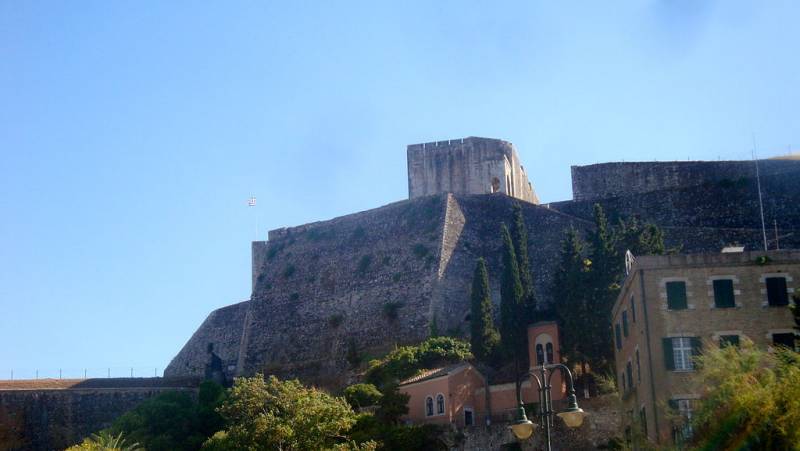
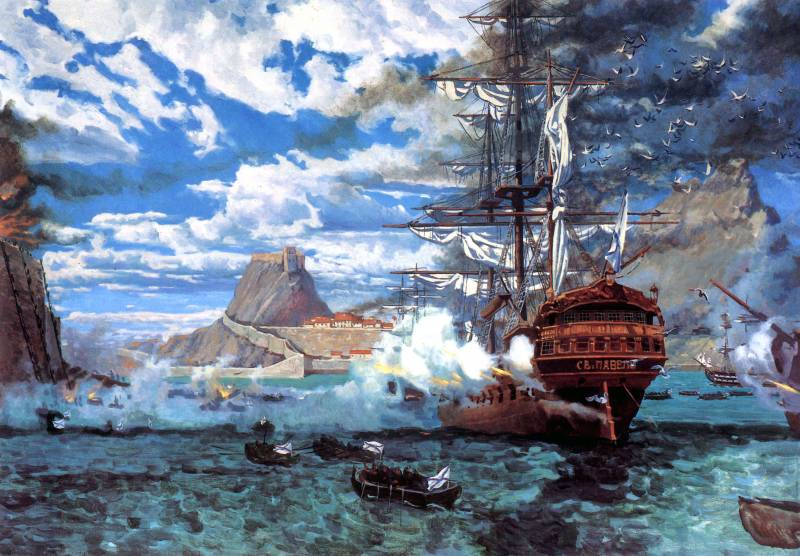
Information